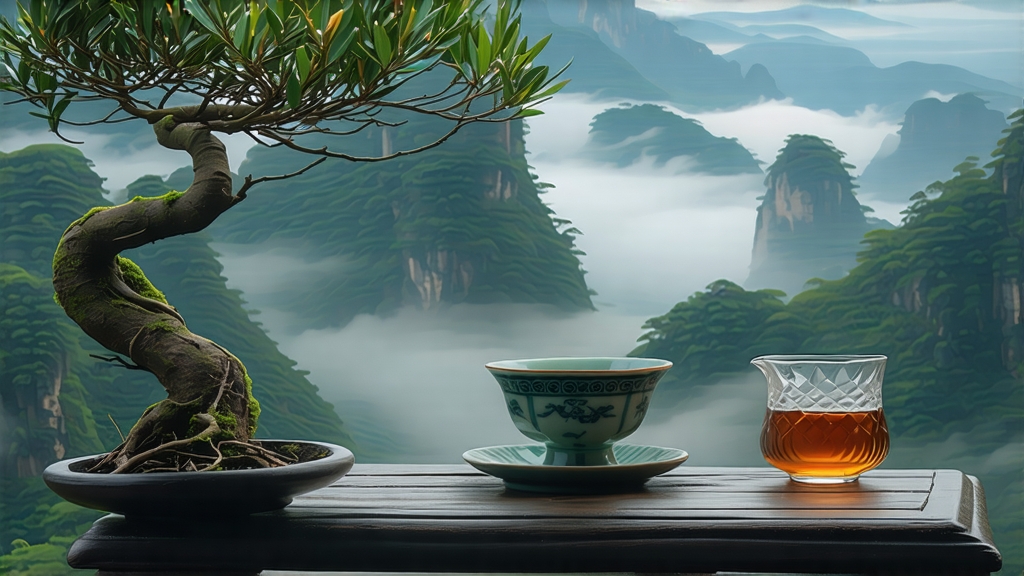
Few names in the vast lexicon of Chinese tea carry the mystique of Tieguanyin, the “Iron Goddess of Mercy.” Hailing from the granite ridges of Anxi in southern Fujian, this emerald-ribboned oolong has, for almost three centuries, seduced poets, merchants, and emperors with its orchid perfume and lingering “yun gan hui”—the sweet, iron-mineral echo that arrives minutes after the last sip. To understand Tieguanyin is to witness a dialogue between soil, craft, and time; it is also to taste the quiet resilience of Anxi’s terraced tea gardens, where morning fog meets the clang of temple bells dedicated to Guanyin herself.
Legend places the cultivar’s birth in the 1720s. A devout farmer named Wei Yin, so the story goes, found a scraggly tea bush behind Guanyin’s abandoned shrine. He replanted it in his yard, and the leaves, once rolled and fired, yielded a liquor so fragrant that villagers believed the goddess had rewarded his piety. Historical records are less romantic but equally telling: Qing-era tax rolls list “Guanyin tea” among tributes sent to the imperial court, and late-19th-century export logs show crates of “Ti-koan-im” leaving Xiamen for Singapore and San Francisco. Thus, Tieguanyin traveled the maritime Silk Road long before the word “oolong” entered English dictionaries.
Botanically, Tieguanyin is a single, somewhat temperamental cultivar—Camellia sinensis var. sinensis ‘Tieguanyin’—that thrives only in Anxi’s acidic lateritic soil. Attempts to transplant it to Guangdong or Taiwan produce leafy ghosts: pleasant, but lacking the mineral spine and cooling orchid note that Anxi’s diurnal temperature swings etch into every cell. Within Anxi, micro-terroirs matter. The township of Xiping, where the legend was born, gives delicate, high-aroma styles. Gande, slightly higher and cooler, yields teas with thicker body and a cream-sweet finish. Xianghua, perched on iron-rich red cliffs, crafts the most mineral-driven, almost flinty expressions. Knowing the village is as important as knowing the vintage in Burgundy.
Modern Tieguanyin is not one tea but a spectrum, its personality shaped by the degree of oxidation and the intensity of roasting. The market loosely divides styles into three arcs. Qing Xiang (“fresh aroma”), popular since the 1990s, is barely 15–20 % oxidized and unroasted. The dry leaf jade-green and seaweed-sleek, the liquor pale straw, the aroma a burst of white orchid and lily. It is Tieguanyin as iced perfume, a style that conquered China’s new tea-shop culture and then the Instagram feeds of New York cafés. Zhong Xiang (“moderate aroma”) stops oxidation around 25 %, then receives a light charcoal bake (60–70 °C for four to six hours). The cup turns golden, the bouquet adds honeyed gardenia, and the throat feel thickens. Finally, Nong Xiang (“rich aroma”) harks back to pre-air-conditioning days: 30–35 % oxidation followed as many as five charcoal roasts over bamboo ash fires that last weeks. The leaf darkens to mahogany, the liquor glows amber, and the palate meets toasted almond, cacao, and the scent of warm temple incense. Each style is the same cultivar speaking different dialects of fire and time.
Craft begins in the pre-dawn chill of late April, when buds have opened into the sought-after “small open face”—two leaves and a bud still tipped in dew. Pickers pinch, never cut, to keep the stem’s canal intact; rupture here invites premature oxidation. The harvest is rushed to the village alleyways where every flat surface becomes a withering bed. Sun-withering lasts only twenty minutes, enough to soften the leaf without bruising the edges. Then comes the crucial “yao qing”—shaking in rattan baskets. A master rhythmically tosses three kilos of leaves overhead, letting them slap against the rim. Cell walls fracture, enzymes meet air, and the signature peach-skin aroma rises. This step is repeated every hour through the night; the craftsman listens for the rustle that signals readiness, a sound apprentices learn by sleeping beside the baskets. Oxidation halts in a 280 °C tumble-roaster for ninety seconds; the leaf must be cooled within forty seconds to lock color. Next, the “bao rou”—